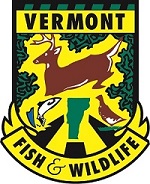
The Vermont Fish & Wildlife Department is reminding anglers and the public to avoid disturbing spawning sea lamprey that may currently be found in the Connecticut River and several of its tributaries.
“Sea lamprey are native to the Connecticut River basin and play a vital role in the ecosystem,” said Lael Will, fisheries biologist with Vermont Fish & Wildlife.
Vermont is also home to a separate population of non-native sea lamprey that are actively controlled as a nuisance species in Lake Champlain. Confusion can arise over the differing management goals for these two populations of Vermont sea lamprey. We believe it is important to highlight and contrast the conservation value of Connecticut River sea lamprey, educate the public and encourage folks to do their part to protect this important population of fish.”
“If you happen to see a spawning sea lamprey or a lamprey carcass, don’t be alarmed,” said Will. “The fish provide a number of important ecological benefits and are considered a Species of Greatest Conservation Need in both Vermont and New Hampshire.”
Each year sea lamprey spawn during the spring in the main stem of the Connecticut River as far upstream as Wilder Dam as well as in many of its tributaries, including the West, Williams, Black and White Rivers.
Upon returning to freshwater to spawn, adult sea lamprey are non-parasitic and die shortly after spawning, and their carcasses play a critical role in cycling important marine nutrients into freshwater ecosystems.
In the Connecticut River, larval lamprey live in freshwater the first few years of their lives, remaining sedentary and burrowed in sandy substrate while filtering detritus from the water for nutrition. At around five years of age, they transform into juveniles and emigrate to the ocean where they attach to and feed on fish as parasites. In turn, lampreys are a food source in the estuarine and marine environment for a number of fish, marine mammals and birds.
While existing for over 350 million years in the Atlantic, anadromous sea lamprey have co-evolved with their oceanic hosts and their populations are considered to be in balance.
The species is currently managed under the Connecticut River Atlantic Salmon Commission, which includes four state agencies, two federal agencies and representatives of the public. Among other efforts, Vermont Fish & Wildlife has been working to improve fish passage facilities within the Connecticut River drainage to enable native sea lamprey to successfully complete their migrations to spawning habitat.
“In 2020, nearly 34,000 sea lamprey have passed the Holyoke Dam, and our goal is to continue to improve fish passage and flows on the river to not only help lamprey spawning, but to also support all migrating fish species,” Will said.
To learn more about Vermont Fish & Wildlife’s various fisheries management programs, visit www.vtfishandwildlife.com.\
For Immediate Release: June 22, 2020
Media Contacts: Lael Will 802-777-0827; Matthew Carpenter 603-271-2612
